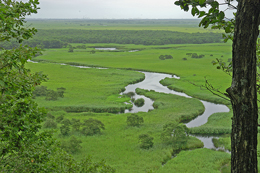
Kushiro Wetland is the largest wetland remaining in Japan, with an area of about 180 km2 (equivalent to the area of Washington, D.C. in USA). It was designated as a Natural Monument in 1967, Japan’s first Ramsar Site in 1980, and the 28th National Park in 1987. Wild Bird Society of Japan also selected Kushiro Wetland as one of the 167 Important Bird Areas.
Vital to the wetland is Kushiro River: with total length of 154km and the watershed area of 2510km2.
Kushiro River connects forested areas in the watershed to ocean and supplies nutrients to nearby coasts. The nutrients are essential for growth of phytoplankton, kelp, and animals that eat them (and therefore essential for maintaining productive fisheries along the coast).
The wetland acts as a reservoir of water and nutrients for terrestrial and marine ecosystems. It also acts as a buffer between the ecosystems and atmosphere: It has been estimated that Kushiro Wetland absorbs about 45,200t CO2 per year. This is equivalent to the amount of CO2 produced by about 9,000 households per year.
Kushiro Wetland supports rich biodiversity: It is a home to about 600 species of plants, 26 species of mammals, four species of amphibians, five species of reptiles, about 170 species of birds, 1,150 species of insects, and 34 species of fish.
Aside from the red-crowned crane, there is a number of species that are charismatic, rare, or endemic to the wetland. The Steller’s sea eagle that visits the wetland and surrounding areas is listed as vulnerable by IUCN. Skhalin taimen is the largest freshwater fish, and its population size has decreased considerably in Japan. Ezo salamander is relatively common across Hokkaido but is endemic to Hokkaido. In Japan, Siberian salamander is found only in Kushiro Wetland but is found widely in north-eastern Eurasia. This species can tolerate freezing of its body during winter. A handful of dragonfly species (such as the mosaic darner) is endemic to Kushiro Wetland.
Kushiro Wetland has been under threat from development in surrounding areas, influx of soil from surrounding hills and farmland, invasion of exotic species, and increasing area of alder woodlands. In a hope to maintain the status and ecological function of Kushiro Wetland, a multidisciplinary team of experts (representing government ministries, local governments, NGOs, and concerned citizens) has been gathered to form the Kushiro Wetland Nature Restoration Council in 2003. The council meets regularly to identify emerging threats, evaluate status of ongoing threats, and prioritize restoration projects. Following recommendations from the council, various restoration projects have been underway. Some examples of restoration projects are removal of exotic species, removal of a source of excess nutrients, restoration of meandering channels, reforestation of surrounding hills, and restoration of wetland areas from pastures on reclaimed land. A breeding pair of red-crowned cranes has returned to a recently restored wetland in the Village of Tsurui.

